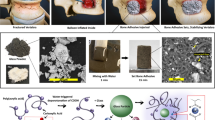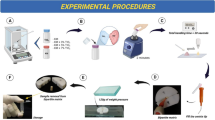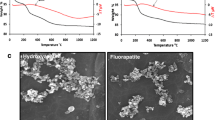Abstract
Titanium (Ti) implants are extensively used in a number of biomedical and dental applications. This work introduces Ti into the glass phase of a zinc based glass polyalkenoate cement (GPC) and investigates changes in handling and mechanical properties considering two molecular weight polyacrylic acids (PAA), E9 and E11. Considering the handling properties, the working time (T w) increased from 50 sE9, 32 sE11 (BT 101, Ti-free) to 169 sE9, 74 sE11 with TW-Z (highest Ti content), respectively. The setting time (T s) increased from 76 sE9, 47 sE11 (BT 101) to 303 sE9, 232 sE11 with TW-Z, respectively. Ti was also found to have a significant increase on both compressive (σ c) and biaxial flexural strength (σ f), where σ c increased from 36 MPaE9, 56 MPaE11 (BT 101) to 56 MPaE9 and 70 MPaE11 with TW-Z respectfully. σ f also increased from 11 MPaE9, 22 MPaE11 (BT 101) to 22 MPaE9 and 77 MPaE11 with TW-Z, respectively. No increase in mechanical properties was evident with respect to maturation. Raman Spectroscopy was employed to investigate changes in glass structure and the setting of the cements with. This revealed increased glass network disruption with increasing TiO2 content and matured cement setting with TW-Z as compared to the control BT 101. FT-IR was then employed to investigate any additional setting mechanism and changes with time. Spectroscopy determined that Ca2+/Sr2+PAA complexes are primarily responsible for the setting and mechanical strength with no changes occurring over time.







Similar content being viewed by others
References
Byon E, Moon S, Cho S-B, Jeong C-Y, Jeong Y, Sul Y-T. Electrochemical property and apatite formation of metal ion implanted titanium for medical implants. Surf Coat Technol. 2005;200(1–4):1018–21.
González JEG, Mirza-Rosca JC. Study of the corrosion behavior of titanium and some of its alloys for biomedical and dental implant applications. J Electroanal Chem. 1999;471(2):109–15.
Schwager K. Titanium as a biomaterial for ossicular replacement: results after implantation in the middle ear of the rabbit. Eur Arch Otorhinolaryngol. 1998;255:396–401.
Lausmaa J. Surface Spectroscopic characterization of titanium implant materials. J Electron Spectrosc Relat Phenom. 1996;81:343–61.
Fawzy AS, El-Askary FS. Effect acidic and alkaline/heat treatments on the bond strength of different luting cements to commercially pure titanium. J Dent. 2009;37:255–63.
Turpin YL, Tardive RD, Tallec A, Le Menn AC. Corrosion susceptibility of titanium covered by dental cements. Dent Mater. 2000;16:57–61.
Takeuchi M, Abe Y, Yoshida Y, Nakayama Y, Okazaki M, Akagawa Y. Acid pretreatment of titanium implants. Biomaterials. 2003;24(10):1821–7.
Takadama H, Kim H-M, Kokubo T, Nakamura T. XPS study of the process of apatite formation on bioactive Ti-6Al-4V alloy in simulated body fluid. Sci Technol Adv Mater. 2001;2:389–96.
Kokubo T, Kim H-M, Kawashita M. Novel bioactive materials with different mechanical properties. Biomaterials. 2003;24:2161–75.
Nicholson JW, Wilson AD. Acid-base cements—their biomedical and industrial applications. In: West AR, Baxter H, editors. Chemistry of solid state materials. Vol. 3. Cambridge: Cambridge University Press; 1993.
Wren AW, Laffir FR, Kidari A, Towler MR. The Structural Role of Titanium in Ca–Sr–Zn–Si/Ti Glasses for Medical Applications. J Non-Cryst Solids. 2010 (Submitted manuscript).
Wren AW, Boyd D, Towler MR. The processing, mechanical properties and bioactivity of strontium based glass polyalkenoate cements. J Mater Sci: Mater Med. 2008;19:1737–43.
Marie PJ. Strontium ranelate; a novel mode of action optimizing bone formation and resorption. Osteoporos Int. 2005;16:S7–10.
Marie PJ. Strontium ranelate: new insights into its dual mode of action. Bone. 2007;40(5):S5–8.
Yamaguchi M, Ma ZJ. Role of endogenous zinc in the enhancement of bone protein synthesis associated with bone growth of newborn rats. J Bone Miner Metab. 2001;19:38–44.
Yamaguchi M, Ma ZJ. Stimulatory effect of zinc on Deoxyribonucleic acid synthesis in bone growth of newborn rats:enhancement with zinc and insulin like growth factor-I. Calcif Tissue Int. 2001;69:158–63.
Wren AW, Boyd D, Thornton R, Cooney JC, Towler MR. Antibacterial properties of a tri-sodium citrate modified glass polyalkenoate cement. J Biomed Mater Res B. 2009;90-B(2):700–9.
Sawai J. Quantative evaluation of antibacterial activities of metallic oxide powders (ZnO, MgO and CaO) by conductimetric assay. J Microbiol Methods. 2003;54:177–82.
Yamamoto O. Influence of particle size on the antibacterial activity of zinc oxide. Int J Inorg Mater. 2001;3:643–6.
Higgs WA, Lucksanasombool P, Higgs RJED, Swain MV. Comparison of the material properties of PMMA and glass ionomer based cements for use in orthopaedic surgery. J Mater Sci: Mater Med. 2001;12:453–60.
Khun K-D. Bone cements: up-to-date comparison of physical and chemical properties of commercial materials. New York: Springer; 2000.
Dunne NJ, Orr JF. Thermal characteristics of curing acrylic bone cement. ITBM-RBM. 2001;22(2):88–97.
Bahna P, Dvorak T, Hanna H, Yasko AW, Hachem R, Raad I. Orthopaedic metal devices coated with a novel antiseptic dye for the prevention of bacterial infection. Int J Antimicrob Agents. 2007;29:593–6.
Heini P, Berlemann U. Bone substitutes in vetebroplasty. Eur Spine J. 2001;10:S205–13.
International Organization for Standardization 9917. Dental Water Based Cements (E), in Case Postale 56: Geneva, Switzerland, CH-11211; 1991.
Williams JA, Billington RW, Pearson GJ. The effect of the disc support system on biaxial tensile strength of a glass ionomer cement. Dent Mater. 2002;18:376–9.
Nicholson JW. Chemistry of glass ionomer cements. Biomaterials. 1998;19:485–94.
Nicholson JW, Brookman PJ, Lacy OM, Wilson AD. Fourier transform infrared spectroscopic study of the role of tartaric acid in glass ionomer cements. J Dent Res. 1988;67:1451–1454.
McMillian PW. Structural studies of silicate glasses and melt-applications and limitations of Raman spectroscopy. Am Mineral. 1984;69:622–44.
Iwamoto N, Tsunawaki Y, Masao F, Hatfori T. Raman spectra of K2O-SiO2 and K2O-SiO2-TiO2 glasses. J Non-Cryst Solids. 1975;18:303–6.
Kusaeiraki K. Infrared and Raman spectra of vitreous silica and sodium silicates containing titanium. J Non-Cryst Solids. 1987;95 & 96:411–8.
Chen CC, Ho C-C, Chen C-HD, Ding S-J. Physicochemical properties of calcium silicate cements for endodontic treatment. J Endod. 2009;35(9):1288–91.
Xie D, Feng D, Chung I, Eberhardt AW. A hybrid zinc-calcium-silicate polyalkenoate bone cement. Biomaterials. 2003;24:2749–57.
De Mayer EAP, Verbeeck RMH, Vercruysse CMJ. Infrared spectroscopic study of acid-degradable glass. J Dent Res. 2002;81(8):552–5.
Tomlinson SK, Ghita OR, Hooper RM, Evans KE. Investigation of the dual setting mechanism of a novel dental cement using infrared spectroscopy. Vib Spectrosc. 2007;45:10–7.
Dong J, Ozaki Y, Nakashima K. Infrared Raman and near-infrared spectroscopic evidence for the coexistence of various hydrogen-bond forms in poly(acrylic acid). Macromolecules. 1997;30:1111–7.
Young AM, Sherpa A, Pearson G, Schottlander B, Waters DN. Use of Raman spectroscopy in the characterization of the acid-base reaction in glass ionomer cements. Biomaterials. 2000;21:1971–9.
Hill RG, Stamboulis A, Law RV, Clifford A, Towler MR, Crowley C. The influence of strontium substitution in fluorapatite glasses and glass-ceramics. J Non-Cryst Solids. 2004;336(3):223–9.
Matsuya S, Maeda T, Ohta M. IR and NMR analysis of hardening and maturation of glass ionomer cement. J Dent Res. 1996;75:1920–7.
Crisp S, Pringuer MA, Wardleworth D, Wilson AD. Reactions in glass ionomer cements: II. An infrared spectroscopic study. J Dent Res. 1974;53:1414–1419.
Acknowledgements
Enterprise Ireland Grant, TD/2005/327.
Author information
Authors and Affiliations
Corresponding author
Rights and permissions
About this article
Cite this article
Wren, A.W., Kidari, A., Cummins, N.M. et al. A spectroscopic investigation into the setting and mechanical properties of titanium containing glass polyalkenoate cements. J Mater Sci: Mater Med 21, 2355–2364 (2010). https://doi.org/10.1007/s10856-010-4089-2
Received:
Accepted:
Published:
Issue Date:
DOI: https://doi.org/10.1007/s10856-010-4089-2




